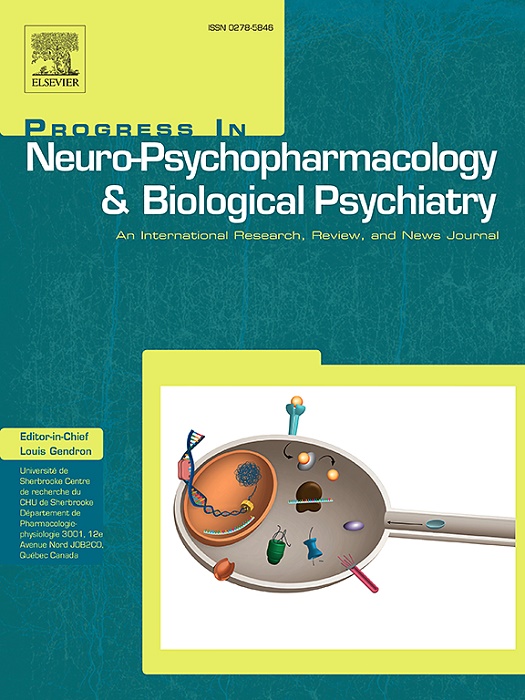Impact of brain redox biomarkers on the emotional and cognitive-related states in male and female adolescent rats: A descriptive analysis
IF 3.9
2区 医学
Q1 CLINICAL NEUROLOGY
Progress in Neuro-Psychopharmacology & Biological Psychiatry
Pub Date : 2025-07-13
DOI:10.1016/j.pnpbp.2025.111447
引用次数: 0
Abstract
Redox imbalance can affect several processes within the brain (e.g., synaptic plasticity, neurotransmitters release and their related pathways), leading to altered emotional and cognitive states. These effects can be particularly detrimental during adolescence, a critical period for brain development when some of the brain areas regulating emotional and cognitive functions, such as prefrontal cortex (PFC) and hippocampus (HIPP), are not fully matured yet. Nonetheless, the role of redox markers in the modulation of emotional and cognitive states in adolescent rodents remains under-investigated. Here, we performed correlation analyses between behavior and biomolecular data of redox markers measured in PFC and HIPP of male and female adolescent naïve rats, together with the evaluation of possible sex differences. Our results reveal sex differences in anxiety-like behavior as well as exploratory activity in the open field test, and in fear memory in the auditory fear conditioning task. Moreover, female rats showed decreased NADPH oxidase 2 (NOX-2) and catalase protein levels in PFC, alongside reduced nuclear factor erythroid 2-related factor 2 (NRF-2) and increased lipid peroxidation content in HIPP, thus highlighting sex differences in these redox markers. When considering both sexes together, NRF-2 and NOX-2 expression in PFC and HIPP correlated with several emotional- and cognitive-related behavioral parameters, suggesting that redox status might affect brain maturation, and thus behavior, during adolescence. Collectively, these findings point towards a possible role of redox-related markers in the occurrence of emotional and cognitive behaviors, providing new insights into their potential as pharmacological targets for the treatment of psychiatric disorders.
脑氧化还原生物标志物对雄性和雌性青春期大鼠情绪和认知相关状态的影响:描述性分析
氧化还原失衡可以影响大脑内的几个过程(例如,突触可塑性,神经递质释放及其相关途径),导致情绪和认知状态的改变。青春期是大脑发育的关键时期,一些调节情绪和认知功能的大脑区域,如前额皮质(PFC)和海马体(HIPP)还没有完全成熟,这些影响在青春期尤其有害。尽管如此,氧化还原标记物在青春期啮齿动物情绪和认知状态调节中的作用仍未得到充分研究。在这里,我们对雌雄青少年naïve大鼠PFC和HIPP中测量的氧化还原标志物的行为和生物分子数据进行了相关性分析,并评估了可能的性别差异。结果表明,性别差异表现在开放性测试中的类焦虑行为和探索性活动,以及听觉恐惧条件反射任务中的恐惧记忆。此外,雌性大鼠PFC中NADPH氧化酶2 (NOX-2)和过氧化氢酶蛋白水平降低,核因子红系2相关因子2 (NRF-2)减少,HIPP中脂质过氧化含量增加,从而突出了这些氧化还原标志物的性别差异。当考虑两性时,PFC和HIPP中NRF-2和NOX-2的表达与一些情绪和认知相关的行为参数相关,这表明氧化还原状态可能影响青春期大脑的成熟,从而影响行为。总的来说,这些发现指出了氧化还原相关标记物在情绪和认知行为发生中的可能作用,为它们作为治疗精神疾病的药理学靶点的潜力提供了新的见解。
本文章由计算机程序翻译,如有差异,请以英文原文为准。
求助全文
约1分钟内获得全文
求助全文
来源期刊
CiteScore
12.00
自引率
1.80%
发文量
153
审稿时长
56 days
期刊介绍:
Progress in Neuro-Psychopharmacology & Biological Psychiatry is an international and multidisciplinary journal which aims to ensure the rapid publication of authoritative reviews and research papers dealing with experimental and clinical aspects of neuro-psychopharmacology and biological psychiatry. Issues of the journal are regularly devoted wholly in or in part to a topical subject.
Progress in Neuro-Psychopharmacology & Biological Psychiatry does not publish work on the actions of biological extracts unless the pharmacological active molecular substrate and/or specific receptor binding properties of the extract compounds are elucidated.

 求助内容:
求助内容: 应助结果提醒方式:
应助结果提醒方式:


